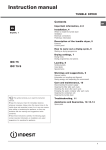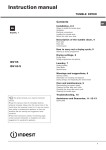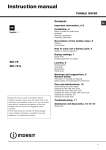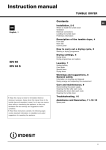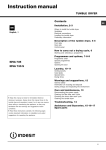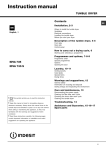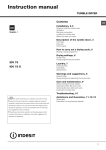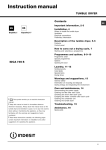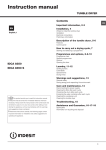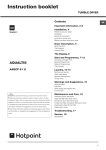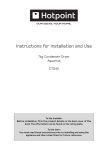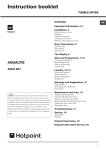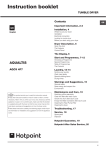Download Indesit IDC85 tumble dryer
Transcript
Instruction manual TUMBLE DRYER Contents EN English, 1 EN Important information, 2-3 Installation, 4 Where to install the tumble dryer Ventilation Electrical connections Preliminary information Description of the tumble dryer, 5 Features Control panel How to carry out a drying cycle, 6 Starting a drying programme Drying settings, 7 Drying times Drying programmes and options IDC 85 Laundry, 8 Sorting laundry Care labels Special items Warnings and suggestions, 9 General safety Information on recycling and disposal Saving energy and respecting the environment Care and maintenance, 10 Disconnecting the power supply Cleaning the filter after each cycle Checking the drum after each cycle Emptying the water container after each cycle Cleaning the condenser unit Cleaning the tumble dryer This symbol reminds you to read this instruction manual. Keep this manual at hand for immediate reference whenever necessary. Always store this manual close to the tumble dryer and remember to pass it on to any new owners when selling or transferring the appliance, so they may familiarise with the warnings and suggestions herein contained. Troubleshooting, 11 Assistance and Guarantee, 12-13-14 Spare parts Read these instructions carefully: the following pages contain important information on installation and useful suggestions for operating the appliance. 1 Important information EN To ensure that the condenser dryer functions efficiently, the following routine maintenance procedures must be carried out: Fluff filter CLEAN off any fluff build-up on the filter after each drying cycle. Failure to clean the filter after each drying cycle will reduce drying performance. The machine will take longer to dry and it will consume more energy. Water container empty the water container after each drying cycle. Step 1 Open the dryer door by pressing it as shown in the picture. 2 Step 1 Pull the water container towards you and remove it completely from the dryer. Step 2 Empty all the water in the water container. Step 2 Pull out the filter (using two fingers). Step 3 Clean off any fluff build-up on the internal surface of the filter net. Step 3 Replace the water container making sure that it is securely fixed. Failure to empty the water container may cause the following: - The dryer stops heating (thus the load may still be damp at the end of the drying cycle). - The Empty water container light lights up to signal that the water container is full. Filling of the Water Container Step 4 Replace the filter never operate the dryer without the filter in place. 2 When the dryer is first used water will not immediately enter the water container as the pump needs to be primed. This is done automatically and will take a few minutes, during this period the efficiency of the drying process is not affected. Condenser unit - remove any fluff build-up from the condenser on a monthly basis. EN Step 1 Open the condenser cover - grip the handle and pull towards you. Step 2 Remove the condenser by turning the 3 catches, then pull the condenser towards you. (It is normal for some residual water to be left in the tubes). Step 3 Clean the condenser with running water over the rear side to remove any fluff deposits. Step 4 Replace the condenser unit; make sure that the unit is securely in place, that all 3 catches are fixed and that the position arrows on the front end of the condenser are pointing upwards. Failure to clean the condenser unit may cause premature faults to the dryer. 3 Installation Electrical connections Install the dryer far from gas ranges, stoves, radiators or hobs, as flames may damage it. If the dryer is installed below a worktop, ensure there are 10 mm between the upper panel of the dryer and any objects above it, and 15 mm between the sides of the machine and the walls or furniture units adjacent to it. This ensures adequate air circulation. Before plugging the appliance into the socket, check the following: Make sure your hands are dry. The socket must have an earth connection. The socket must be able to withstand the machines maximum power output as indicated on the data plate (see Description of the tumble dryer). The power supply voltage must fall within the values indicated on the data plate (see Description of the tumble dryer). The socket must be compatible with the dryers plug. Should this not be the case, replace the plug or the socket. Do not use extension cords. The dryer must not be installed outdoors, even if the space is sheltered. It can be very dangerous if exposed to rain or storms. Once installed, the dryers electrical wire and plug must be within reach. The power cord must not be bent or squashed. The power cord is supplied fitted with a BS1363 plug and with a 13 amp BS1362 fuse. If it is necessary to fit a replacement fuse, it must be a 13 Amp ASTA approved to BS1362 type. WARNING: The plug must not be used without a fuse cover. If a replacement fuse holder/cover is required, it must be of the same colour coding or wording as shown on the base of the plug. Replacements are available from authorised dealers. 10 mm Where to install the tumble dryer 15 mm 15 mm Ventilation The room must be adequately ventilated while the dryer is running. Make sure that the dryer is installed in a room free of humidity and with adequate air circulation. The flow of air around the dryer is essential to allow water to condense during drying; the dryer will not function properly if it is placed in an enclosed space or inside a cabinet. Some condensation may form if the dryer is used in a small or cold room. We do not recommend that the dryer is installed in a Moulded plug cupboard but the dryer must never be installed behind a lockable door, a sliding door or a door with a hinge on the opposite side to that of the dryer door. Water drain If your dryer is installed next to a drain the water can be plumbed into this drain. This does away with the need to empty the water container. If the dryer is stacked onto or installed next to a washing machine it can share the same drain. The height of the drain must be less than 3' (1 m) from the bottom of the dryer. Remove existing hose from position shown in picture A and fit a suitable length of hose and connect as shown in picture B. Changing the plug The wires in the power cord are coloured in accordance with the following. Green and Yellow (Earth) wire to terminal marked E, symbol x, or coloured green and yellow. Make sure that the hose is not squashed or kinked when the dryer is in its final location. 1 BLUE 13 ampere fuse CROSS-BAR CORD GRIP Brown (live) wire to teminal marked L or coloured red. 2 1 Picture A 13A ASTA approved fuse to BS 1362. GREEN & YELLOW BROWN Blue (Neutral) wire to terminal marked N or coloured black. 2 Less than 1m EN Picture B If the plug being replaced is a non-rewirable type, then the cut-off plug must be disposed of safely. DO NOT leave it where it can be inserted into a socket and create a shock hazard. The power cord should be checked periodically and replaced by a cord specially prepared for this dryer and fitted only by authorized technicians (see Service). New or longer power cords are supplied at an extra charge by authorized dealers. The manufacturer denies any responsibility should any of these rules not be followed. If in doubt about any of the above consult a qualified electrician. Preliminary information Once the tumble dryer is installed, clean the inside of the drum before operating it and remove any dirt accumulated during transportation. 4 Description of the tumble dryer Opening the door Features EN Press the door Rating plate Water container Model & Serial Numbers Filter Air intake grille Condenser unit (cover open) Condenser cover handle (pull to open) Control panel High Heat button Drying time selector knob Start button Empty water container indicator light Drying time selector knob This is used to set the drying time: turn the knob in a clockwise direction until the indicator is set to the desired drying time (see Drying settings). Do not attempt to turn the knob anticlockwise. High Heat button It can be used to customise the selected programme in accordance with your own requirements. START button Press the button to begin drying. Empty water container indicator light The Empty water container indicator light signals that the water container must be emptied. If the container becomes full during the programme, the tumble dryer will automatically start the cold air cycle. In order to avoid this procedure, always empty the water container after using the tumble dryer (see Care and maintenance). 5 How to carry out a drying cycle Starting a drying programme EN 1. Plug the dryer into the power supply socket. 2. Select a suitable drying programme for the type of laundry (see Laundry). 3. Open the door, ensure that the filter is clean and securely placed and that the water container is empty and correctly slotted (see Care and maintenance). 4. Load the machine, making sure that no piece of laundry gets between the door and the relative seal. Close the door. 5. Turn the Drying time selector knob until the indicator is pointing towards the most suitable drying time for the type of fabric in that load. Use the table to check the relationship between fabric type and load capacity (see Drying settings), and make sure you are familiar with the instructions provided for each type of fabric (see Laundry). Do not attempt to turn the knob anticlockwise. 6. If necessary, set the temperature using the HIGH HEAT button. 7. Press the START button to start the drying cycle. Laundry can be checked while the drying programme runs and any garments already dry can be removed, while drying continues for the remaining items. After closing the door, press the START button to resume machine operation. 8. The final COLD DRYING phase (i.e. the fabrics are cooled) activates during the last few minutes of the drying programme; always allow this phase to terminate. 9. Open the door, remove the laundry then clean the filter and replace it. Empty the water container and put it back in its slot (see Care and maintenance). 10. Disconnect the dryer from the power supply. 6 Drying settings Drying times EN The drying time depends on the size of the load and on the type of fabric it contains (see Table). The cold drying cycle runs during the final 10 minutes of the programme. For large loads, select the High Heat option if available. Fabric Cotton – high heat Synthetics – low heat Acrylics – low heat Load 1 kg 30 - 40 minutes 40 - 50 minutes 40 - 60 minutes 2 kg 40 - 55 minutes 50 - 70 minutes 55 - 75 minutes 3 kg 55 - 70 minutes 70 - 90 minutes 4 kg 70 - 80 minutes 5 kg 80 - 90 minutes 6 kg 95 - 120 minutes 7 kg 120 - 140 minutes 8 kg 130 - 150 minutes - - - - - - - - - - - Drying times are approximate and may vary depending on the following: Amount of water retained by items after the spin cycle: towels and delicate items retain a lot of water. Fabrics: items of the same fabric, but with different texture and thickness may have different drying times. Amount of laundry: single items and small loads will take a short time to dry. Drying: if items are to be ironed, they can be removed from the dryer while still slightly damp. Items that require complete drying can be left longer. Temperature of the room: the lower the temperature of the room, the longer it will take for the dryer to dry clothing. Bulk: certain bulky items require special care during the drying process. We suggest removing these items and replacing them in the dryer once they have been shaken out: repeat this procedure several times during the course of the drying cycle. Do not over-dry items. All fabrics contain natural dampness which helps to keep them soft and fluffy. Drying programmes and options Refresh A short programme suitable for refreshing fibres and garments through the emission of cool air. It lasts about 10 minutes. As this is not a drying programme, it is not to be used for garments that are still wet. High Heat button The high heat button selects the drying temperature. When the button is out low heat is selected and when it is pushed in high heat is selected. 7 Laundry EN Sorting laundry Care labels Check the symbols on the care labels of the various garments to verify whether the garments can be safely tumble dried. Sort laundry according to the type of fabric. Empty all pockets and check for loose buttons. Close zips and hooks and fasten belts and strings without tightening them. Wring out garments to remove the maximum amount of water possible. Always check the care labels, especially when placing garments in the tumble dryer for the first time. Below are the most commonly used symbols: Do not load the dryer when garments are dripping wet. Items not suitable for tumble drying: Items containing rubber parts or similar materials, or plastic film covering (pillows, cushions or PVC sports jackets), any type of inflammable object or objects containing inflammable substances (used towels containing hairspray). Glass fibres (certain types of draperies). Items which have been previously dry cleaned. Items marked with the ITLC symbol (Special garments) , which may be washed using special household products. Follow instructions carefully. Large bulky items (duvets, sleeping bags, pillows, cushions, etc.) that expand when dried and hamper air circulation inside the tumble dryer. Maximum load sizes Do not overload the drum. The following values indicate the weight of dry garments: Natural fibres: maximum 8 kg Synthetic fibres: maximum 3 kg Do not overload the dryer as this may result is reduced drying performance. Typical weights Note: 1 kg = 1000 g Garments Blouse Cotton Other Dress Cotton Other 150 100 500 350 700 g Jeans 1,000 g 10 Nappie Shirt g g g g 300 g 200 g Cotton Other T-shirt 125 g Household linen Duvet cover (double bed) Cotton Other 1,500 g 1,000 g Large tablecloth 700 g Small tablecloth 250 g Tea cloth 100 g Bath towel 700 g Hand towel 350 g Double bed sheet 500 g 350 g Single bed sheet When mixing synthetic fibres with cotton garments, the latter may still be damp at the end of the drying cycle. If this happens, simply put them through a short drying cycle. Note: when setting the duration of the drying cycle, remember that the cold drying phase runs during the last 10 minutes, during which the dryer does not dry the garments. 8 May be tumble dried. Do not tumble dry. Tumble dry high heat. Tumble dry low heat. Special items Blankets and bedcovers: acrylic items (Acilian, Courtelle, Orion, Dralon) must be dried with great care at low heat. Avoid drying for long periods. Creased or pleated garments: read the drying instructions supplied by the manufacturer. Starched garments: do not dry together with nonstarched items. Remove the maximum amount of starch solution possible before placing these items in the dryer. Do not over-dry: starch turns powdery leaving garments limp this defeats its purpose. Warnings and suggestions This appliance was designed and manufactured in compliance with current international safety standards. The following information is provided for safety reasons and must be read carefully. General safety The final part of a tumble dryer cycle occurs without heat (cooling cycle) to ensure that the laundry is not damaged due to excessive temperatures. This tumble dryer must not be used by persons (including children) with physical, sensory or mental impairments or with little experience and knowledge of the appliance, unless they are supervised or have been adequately instructed on its use by the person responsible for their safety. This tumble dryer is designed for domestic and nonprofessional use. Do not touch the appliance while barefoot or with wet hands or feet. Unplug the appliance by pulling on the plug, not the cord. Do not allow children near the appliance while it is in function. After use, switch the appliance off and unplug it. Keep the appliance door closed to prevent children using it as a toy. Children must be supervised to ensure that they do not play with the appliance. The appliance must be correctly installed and receive adequate ventilation. The air intake on the front part of the dryer and the air vents on the rear must never be obstructed (see Installation). Never use the dryer on carpeting with high pile as this may prevent air from entering the dryer from the base. Check whether the dryer is empty before loading it. The rear part of the dryer may become very hot: do not touch it while the appliance is in function. Do not use the dryer unless the filter, water container and condenser are properly positioned (see Maintenance). Do not use liquid fabric softener in the dryer; add it to the final rinse of the wash cycle. Do not overload the dryer (see Laundry for the maximum load sizes). Do not add items that are dripping wet. Tumble dry items only if they have been washed with water and detergent, and have been rinsed and put through a spin cycle. Drying items that have NOT been washed with water may cause the risk of fire. Always read the instructions on the care label carefully (see Laundry). Do not tumble dry items that have been treated with chemical products. Never tumble dry items that are contaminated with inflammable substances (cooking oil, acetone, alcohol, petrol, kerosene, stain removers, turpentine, waxes, wax removers and hairspray), unless they have been washed in hot water with an extra amount of detergent. Do not tumble dry rubber, rubber-backed articles and garments, cushions with foam rubber padding, latex foam, rubber, plastic, shower caps, water-resistant fabrics, nappy pants or liners, polyethylene and paper. Remove all objects from pockets, particularly lighters (risk of explosion). Do not tumble dry large, excessively bulky items. Do not tumble dry acrylic fibres at high temperatures. Complete each programme with the relative cold drying phase. Do not switch the tumble dryer off if items that are still warm are inside it. Clean the filter after each use (see Care and maintenance). Empty the water container and put it back in place after each use (see Care and maintenance). Clean the condenser unit regularly (see Care and maintenance). Do not allow lint to build up around the tumble dryer. Avoid climbing on the top of the dryer as this may damage the appliance. Always comply with electrical regulations and requirements (see Installation). Always purchase original accessories and spare parts (see Assistance). WARNING: Never stop the dryer before the end of the drying cycle unless all items have been quickly removed and hung in order to dispel heat. Information on recycling and disposal As part of our continual commitment towards environmental protection, we reserve the right to use recycled quality components to reduce costs for our customers and to minimise materials wastage. Disposing of the packaging materials: follow local regulations to allow for recycling of packaging materials. In order to minimise the risk of injury to children, remove the door and plug, then cut the power supply cord flush with the appliance. Dispose of these parts separately to prevent the appliance from being connected to a power supply socket. Disposal of old household appliances European Directive 2002/96/EC concerning Waste Electrical and Electronic Equipment (WEEE) states that household appliances should not be disposed of using the normal solid urban waste cycle. Exhausted appliances should be collected separately in order to optimise the cost of re-using and recycling materials comprising the machine, while preventing potential damage to public health and the environment. The crossed-out wheeled bin symbol appears on all products to remind owners of the obligations regarding separate waste collection. Owners should contact their local authorities or appliance dealers for further information concerning the correct disposal of household appliances. Saving energy and respecting the environment Wring out items before tumble drying them to remove the maximum amount of water possible (if they are previously washed in a washing machine, select a spin cycle). This ensures that energy is saved during tumble drying. Always use the tumble dryer at full load to save energy: single items and small loads may take longer to dry. Clean the filter at the end of each cycle to reduce energy consumption costs (see Care and maintenance). 9 EN Care and maintenance EN Disconnecting the power supply Disconnect the dryer when not in use or during cleaning and maintenance operations. Cleaning the filter after each cycle The filter is a fundamental component of the dryer: its function is to collect lint and fluff that form during drying. Clean the filter once drying is completed, by rinsing it under running water or cleaning it with a vacuum cleaner. Should the filter become clogged, the flow of air inside the dryer will be seriously hampered: drying times becomes longer and more energy is consumed. Moreover, the dryer may become damaged. The filter is located in front of the dryer seal (see Picture). Removing the filter: 1. Pull the filters plastic handle upwards (see Picture). 2. Clean the fluff off the filter and replace it correctly. Ensure that the filter is pushed fully home. Do not use the dryer unless the filter has been replaced in its holder. Checking the drum after each cycle Rotate the drum manually to remove smaller items (handkerchiefs) that could have been left inside the dryer. Cleaning the drum Avoid using abrasives, steel wool or stainless steel Emptying the water container after each cycle Remove the water container and empty it into a sink or other suitable drain outlet, then replace it correctly. Always check the water container and empty it before starting a new drying cycle. Cleaning the condenser unit Remove the condenser (see Picture below) unit regularly (monthly) and clean off any fluff deposits from the plates by rinsing it with cold water running on the rear end of the condenser. Removing the condenser: 1. Disconnect the dryer from the power supply and open the door. 2. Open the condenser cover (see Picture below), unlock the three catches by turning them 90° anti-clockwise, then pull on the grip to remove the condenser. 3. Clean the surface of the seals and replace the unit with the arrows pointing upwards, while making sure that the catches are securely fixed. Cleaning the tumble dryer The external metal, plastic and rubber parts can be cleaned with a damp cloth. Clean the front air intake grille regularly (every 6 months) with a vacuum cleaner to remove any lint, fluff or dust deposits. Furthermore, remove any lint deposits from the front part of the condenser and from the filter area, using a vacuum cleaner every so often. Do not use solvents or abrasives. Have the dryer checked regularly by authorised technical personnel in order to ensure that the electrical and mechanical parts work safely (see Assistance). cleaning agents to clean the drum. A coloured film may appear on the stainless steel drum surface: it may be caused by a combination of water and/or cleaning agents such as wash-softeners. This coloured film does not affect the dryers performance. Water container Filter Tap Rear Condenser unit Air intake Front Condenser unit Catches 10 Condenser cover Handle Troubleshooting If you feel that the dryer is not working properly, consult the following troubleshooting suggestions before contacting the Technical Assistance Centre (see Assistance). Problem: Possible causes / Solutions: The dryer does not start. Drying times are too long. The filter has not been cleaned (see Care and maintenance). The water container must be emptied? The Empty water container indicator light is on (see Care and maintenance). The condenser needs to be cleaned (see Care and maintenance). An incorrect drying time was selected for the type of load (see Laundry). The air intake grille is blocked (see Installation and Care and Maintenance). The items are too wet (see Laundry). The dryer is overloaded (see Laundry). The dryer is noisy during the first few minutes of operation. This is normal, especially if the dryer has not been used for a long time. If the noise persists during the entire cycle, contact the Technical Assistance Centre. The plug has not been inserted far enough into the socket to make contact. There has been a power cut. The fuse has blown. Try connecting another appliance to the same socket. If an extension cord is used, try connecting the dryer plug directly into the socket. The door has not been closed properly. The programme has not been set correctly (see How to carry out a drying cycle). The START button has not been pressed (see How to carry out a drying cycle). 11 EN Assistance EN Before contacting the Technical Assistance Centre: Follow the troubleshooting guide to check whether problems can be solved personally (see Troubleshooting). If not, switch the dryer off and contact the Technical Assistance Centre closest to you. Provide the following data when contacting the Technical Assistance Centre: Spare parts This dryer is a complex machine. Attempting to repair it personally or with the aid of an unqualified personnel may put the safety of people at risk, damage the machine or invalidate the spare parts guarantee. Always contact a qualified technician when experiencing problems with this machine. The spare parts were designed exclusively for this machine and should not be used for any other purpose. name, address and postal code telephone number type of malfunction date of purchase the appliance model (Mod.) the dryers serial number (S/N) This information can be found on the data plate located behind the door. This appliance conforms to the following EEC directives: - 2006/95/EC (Low Voltage Directive) - 89/336/EEC, 92/31/EEC, 93/68/EEC (Electromagnetic Compatibility Directive). 12 Guarantee 12 Months Parts and Labour Guarantee Your appliance has the benefit of our manufacturers guarantee, which covers the cost of breakdown repairs for twelve months from the date of purchase. This gives you the reassurance that if, within that time, your appliance is proven to be defective because of either workmanship or materials, we will, at our discretion, either repair or replace the appliance at no cost to you. This guarantee is subject to the following conditions: - The appliance has been installed and operated correctly and in accordance with our operating and maintenance instructions. The appliance is used only on the electricity or gas supply printed on the rating plate. The appliance has been used for normal domestic purposes only. The appliance has not been altered, serviced, maintained, dismantled, or otherwise interfered with by any person not authorised by us. Any repair work must be undertaken by us or our appointed agent. Any parts removed during repair work or any appliance that is replaced become our property. The appliance is used in the United Kingdom or Republic of Ireland. The guarantee does not cover: - Damage resulting from transportation, improper use, neglect or interference or as a result of improper installation. Replacement of any consumable item or accessory. These include but are not limited to: plugs, cables, batteries, light bulbs, fluorescent tubes and starters, covers and filters. Replacement of any removable parts made of glass or plastic. THIS GUARANTEE WILL NOT APPLY IF THE APPLIANCE HAS BEEN USED IN COMMERCIAL OR NON-DOMESTIC PREMISES. 5 Year Parts Guarantee Indesit also offers you a free 5 year parts guarantee. This additional guarantee is conditional on you registering your appliance with us and the parts being fitted by one of our authorised engineers. There will be a charge for our engineer's time. To activate the extra parts warranty on your appliance, simply call our registration line on 08448 24 24 24 (Republic of Ireland 01 230 0800) Extended Guarantees We offer a selection of repair protection plans that enable you to fully cover yourself against the expense of repair bills for the life of your policy. To find the ideal plan for you please call our advice line on 08448 226 226 (Republic of Ireland 01 230 0233). Free Helpdesk Service We have a dedicated team who can provide free advice and assistance with your appliance if you experience any technical difficulties within the first 90 days of ownership. Simply call our Indesit Service Hotline on 08448 224 224 (Republic of Ireland 0818 313 413)for telephone assistance, or, where necessary, to arrange for an engineer to call. 13 EN EN After Sales Service No one is better placed to care for your Indesit appliance during the course of its working life than us - the manufacturer. Essential Contact Information Indesit Service We are the largest service team in UK and Ireland offering you access to 400 skilled telephone advisors and 1100 fully qualified engineers on call to ensure you receive fast, reliable, local service. UK: 08448 224 224 Republic of Ireland: 0818 313 413 www.indesitservice.co.uk Please note: Our advisors will require the following information: Model number: Serial number: Parts and Accessories We supply a full range of genuine replacement parts as well as accessory products that protect and hygienically clean your appliance to keep it looking good and functioning efficiently throughout its life. UK: 08448 225 225 Republic of Ireland: 0818 313 413 www.indesitservice.co.uk Appliance Registration We want to give you additional benefits of Indesit ownership. To activate your free 5 year parts guarantee you must register your appliance with us. UK: 08448 24 24 Republic of Ireland: 01 230 0800 www.indesitservice.co.uk Indesit Company UK Ltd. Morley Way, Peterborough, PE2 9JB Indesit Company Unit 49 Airways Industrial Estate, Dublin 17 Recycling & Disposal Information As part of Indesit's continued commitment to helping the environment, Indesit reserves the right to use quality, recycled components to keep down customer costs and minimise material wastage. Please dispose of packaging and old appliances carefully. To minimise the risk of injury to children, remove the door, plug and cut the mains cable off flush with the appliance. Dispose of these parts separately to ensure that the appliance can no longer be plugged into a mains socket, and the door cannot be locked shut. 14 EN 15 195083886.00 01/2010 - Xerox Fabriano EN 16
















